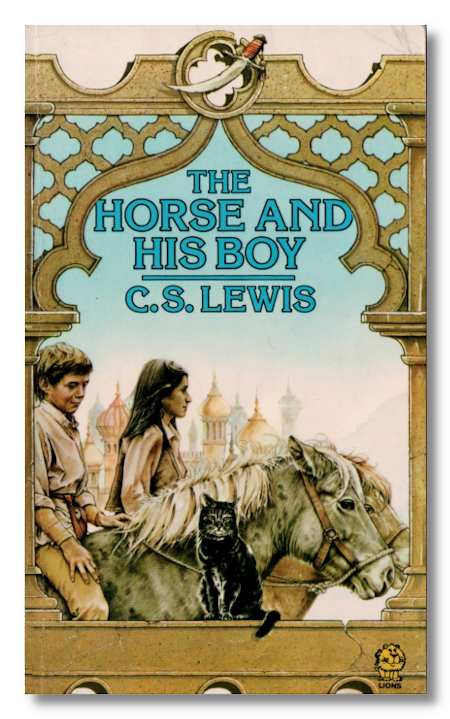Let’s talk about the best Narnia book.
Content Warning: Racism!
The Horse And His Boy, titled after an explicit example of a character saying well actually to a woman, is the story of Bree, a talking horse trapped far away from Narnia, in the southern reaches of –
Oh.
Yikes.
Sooooo this is a Narnia story set mostly in Calormene, a nation that one could describe as ‘a bit like Ottoman Turkey, as described entirely by a British racist.’ I’ve described it before, but the similarities to an Orientalist conception of ‘The Middle East’ involves including everything that you’d want out of that particular laundry list of concepts. It even mentions genies that don’t appear in the story to make sure you’re aware that hey, there could be genies. There’s a fat imperial lord with an Arabish-sounding name (may he live forever), pointy helmets and banners and worship of a war god and snakes and baskets and sherbert and harems and silks and veils and yes it’s all there, it’s a lot.
The Calormenes as a culture are awful, a vessel into which Lewis pours everything he wants to, this time around, to represent the failings of a society. They are represented as being fundamentally and exceptionally bad, with the list of their societal crimes including arranged marriages, excessive capitalism, degradation of women, the exploitation of the environment, disrespect of animals and animal rights, and beating their slaves. Woven in this litany of obvious failings of the British Empire Lewis saw as a ‘good thing,’ though, there is a lot of acceptance that speaks to the sin. The problem is not capitalism, nor misogyny, nor slaves, but rather too much of it by bad people.
The Calormenes have a king who is said to be divinely chosen and empowered by a god. Narnia has exactly the same thing, but the Narnian kings actually were chosen by God. There are entire classes of animal in Narnia made to be servants, but they don’t beat them. There is capitalism and trade and poverty in Narnia and the North, but they’re not doing it too much.
The result of this, where Lewis dreams up a guy to get mad at, except it’s a country, and to give it some tangible difference as a culture to Narnia and Archenland (literally ‘Narnia, but next to Narnia’) decides to make everyone in it some variety of Muslim-expy, is the kind of thing that some galaga-brain take supergeniuses of the modern media landscape would like to explain away, rearranging the letters of racism until we all forget that is clearly how it fucking started. Oh, he may not have started with racist intent, but we don’t have to do things with a roadmap for racism to just be racist. Turns out, replicating racist art you haven’t considered or actively resisted is a great way to just do a racism because the toolkit for racism is just sitting there and would you look at that, the people who built your version weren’t planning on it either.
Point is: The Horse And His Boy may be the best Narnia novel, but it is not in any way protected from the flaws that permeate Lewis’ books. Strong characterisation, a coherent narrative, excellent use of words in space, they are all present, and even a moral lesson or two I carry with me to this day, but boy fucking howdy is this work fucking racist.

Okay let’s get back to that plot thing.
Bree is a talking horse, from Narnia, whisked away from Narnia as a wee foal and used as a normal horse down in the depths of the state of the evil Calormenes. One day, Bree finds a human boy, named Shasta, who Bree recognises as also being from the northern lands, through the desert. The pair resolve to make an escape before Shasta is sold into slavery to go even further away from his true home, and the pair start the perilous trek to their lost home. Along the way, they pick up Aravis, a young Calormene lady who is obviously an example of how they’re not all evil, and her talking horse, Hwin, who is a good and humble and thoughtful horse who isn’t a huge jerk about things the way Bree is.
They also learn about a plan to invade Archenland, Narnia’s window box, an attempt to kidnap Susan (yes, Susan, that Susan, even here we are not free of Pevensies) and force her to marry an Evil Carmolene Prince (who I was relieved to find I misremembered and was never called a “Swarthy Prince”), about the Prince of Archenland, Corin Thunderfist, who is the best Prince in all of these books, and a host of other small slivers of story. Eventually, the heroes flee Calormen, head to Archenland, cross a desert, prepare for the invasion, defend Archenland, humiliate that same Prince through mildly inappropriately placed masonry (in a description that doesn’t make sense, but whatever, whatever, shut up, Aslan did it), discover Shasta is that prince’s identical twin brother and the true heir of Archenland, and everything sorts itself out thanks to Prophecy and All Things Working Together For Good.
It’s a really robust little fantasy story, set in a world with interesting rules and the capacity to use those different rules in different ways. The fact that Narnia is flat plays into the plot at one point, after all. The characters are twee in that child’s book way, but because Shasta and Aravis are humans from Narnia, not Londoners, the metaphors they use, and the way they treat one another is a little less Rather, I Say, Mother, a bit less Enid Blyton’s Tedious Twerps. Plus, the central premise of the title is that Bree is important to this story, and has a different opinion to Shasta as to who the story is about, and that’s a really nice bit of consideration to do of the story’s fundamental values.
Like, of all the Narnia books, this one is the most contained. The least likely to leave you with questions like ‘yo, what the fuck,’ even if the book’s central plot is essentially Aslan rolling natural 20s forever, because he’s god (but not an allegory for Jesus).

It sounds like I’ve done nothing but complain. Why then do I call this the best Narnia book?
There are three lessons in this book, one when I first read it, one when I read it a second time, and one I learned, reading it ten years later.
The first is that after successfully crossing a desert and saving his friends and delivering an emerency message to a wizard of Archenland, Shasta is sent on to deliver the message to Narnia. Why? It seemed so unfair. But first, he was the only one who could do it. The wizard said: Sometimes, the reward for doing your best was to be asked to do even more. It’s a lesson that I found very comforting, a realisation of the unfairness of it all.
The second was after reading the way that Bree doubted Aslan as a real person; the way that Bree made the very sensible, very literal consideration that gods probably weren’t as materially present or cosmically powerful as they were said to be, and it was funny, because he said this kind of stuff about how Aslan probably wasn’t a talking lion, and Aslan was right there, and hahah, look at that, now Bree has to learn a lesson in humility. The second time I read that I was struck with what an asshole move it was for Aslan to need to flex on someone who had no reason to believe that Aslan was real, since he had been orphaned from his world. Then I realised that Bree was only this kind of skeptic because Lewis wanted to make fun of Biblical skeptics, because he was a literalist, and literalists are shitheads.
Finally, and this is after only a long time away from this book and rereading it nearly ten years ago now. I found that this book left an impression on me, in the way I write.
There’s a passage in this book that I know is somewhere entwined in the DNA of my own writing. It’s a section where the heroes of the story are crossing a desert, a flat desert on a flat world. They’re travelling as best can be sensibly determined, but the task is still a full day’s travel across a vast and dull featureless plain, where the landmarks in front of you and the landmarks behind you neither appear nor disappear. There’s no horizon, there’s just onwards, and away, and the two pages of the book dedicated to this explain it as a series of miserable moments, of the pervasive, enduring, agonising boredom of doing something awful in awful conditions, the sort of oppressive heat that a sensible person would say no, I am stopping this now, knowing that one has no option. It is two pages of text, and those two pages have lingered in my own writing ever since, when considering how to empathetically describe an experience if not a sequence.
Smell of hot horse, smell of hot self.

1 Trackback